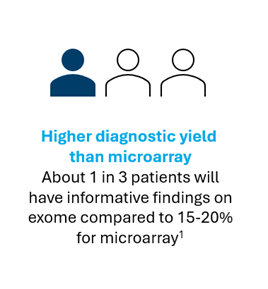Overview
In the evolving world of genetic testing, the evaluation of children with rare disease and neurodevelopmental disorders has typically focused on two tests: chromosomal microarray (CMA) and exome sequencing. While both are highly valuable tests capable of uncovering underlying genetic conditions, there are currently mixed practices around the order in which they are used in a genetics evaluation. In today’s discussion, we will explore the benefits of both these testing methods and articulate why an exome-first testing approach is supported by the latest evidence.
Understanding CMA and Exome Testing
Professional medical guidelines from the American Academy of Pediatrics, the American College of Medical Genetics and Genomics, the National Society of Genetic Counselors, and the American Epilepsy Society support genetic testing for children presenting with multiple birth defects, global developmental delay, intellectual disability, autism spectrum disorder, unexplained epilepsy, and other neurodevelopmental disorders.1-3
CMA, also known as SNP Array at Ambry Genetics, looks for large deletions or duplications in the genome. It does this by detecting copy number variants (CNVS): large sections of DNA (5-10 kilobases or larger) that are missing, duplicated, or rearranged.
Exome testing, also known as whole exome sequencing, is a comprehensive genetic test that examines all the genes in the human genome, specifically focusing on the exons or the coding regions of the DNA. Because exome testing sequences DNA, it can identify much smaller changes than CMA—down to a change in a single letter, or base pair, of DNA. Exome testing can also evaluate for CNVs, identifying deletions and duplications above certain technical thresholds.

Better Diagnostic Yield with Exome Testing
With two tests available, it can be challenging to know which to select as the first-line tool. Based on the current medical literature, CMA has a diagnostic yield of 15-20%. In contrast, the yield for exome testing lies somewhere between 25 to 35%, depending on the indication for testing. 4 Bottom line: exome testing will provide more answers for more patients when it is chosen as the first line of testing.
Health Plan Policies Have Shifted to Allow First-line Exome Testing
So, why do some providers still order CMA first? This practice seems to mainly be a legacy of health plan policy, which historically required a negative CMA result to get an exome test covered by insurance. However, health plan policies have evolved in recent years to allow exome testing without any prior testing requirement. A recent audit we conducted of policies related to exome testing from all major payers revealed that insurance companies are now regularly covering exome testing without needing a chromosome microarray to be performed first.5
CMA Testing Has Value as a Reflex Test
While exome testing can identify many CNVs that would be detected on CMA, its performance has some limitations. In cases where exome testing results are negative or uninformative, reflexing to a CMA should be considered. In most labs, testing can be ordered in a reflex cascade when the original sample is submitted, and no additional sample collection is required.
Conclusion
While both chromosome microarray and exome sequencing have their distinct benefits and uses, the decision on which test to utilize first depends on the diagnostic yield and insurance coverage. As the genetics evaluation continues to evolve, it becomes more apparent that an exome-first testing workflow is the best fit towards achieving an accurate, efficient diagnosis.
References:
-
Hyman SL, Levy SE, Myers SM, et al. Identification, Evaluation, and Management of Children with Autism Spectrum Disorder. Pediatrics. 2020;145(1):e20193447. doi:10.1542/peds.2019-3447.
-
Manickam K, McClain MR, Demmer LA, et al. Exome and genome sequencing for pediatric patients with congenital anomalies or intellectual disability: an evidence-based clinical guideline of the American College of Medical Genetics and Genomics (ACMG). Genet Med. 2021;23(11):2029-2037. doi:10.1038/s41436-021-01242-6.
-
Smith L, Malinowski J, Ceulemans S, et al. Genetic testing and counseling for the unexplained epilepsies: An evidence‐based practice guideline of the National Society of Genetic Counselors. J Genet Couns. 2023;32(2):266-280. doi:10.1002/jgc4.1646.
-
Srivastava S, Love-Nichols JA, Dies KA, et al. Meta-analysis and multidisciplinary consensus statement: exome sequencing is a first-tier clinical diagnostic test for individuals with neurodevelopmental disorders. Genet Med. 2019;21(11):2413-2421. doi:10.1038/s41436-019-0554-6.
-
Ambry internal audit of major health plan policies, 2024.



